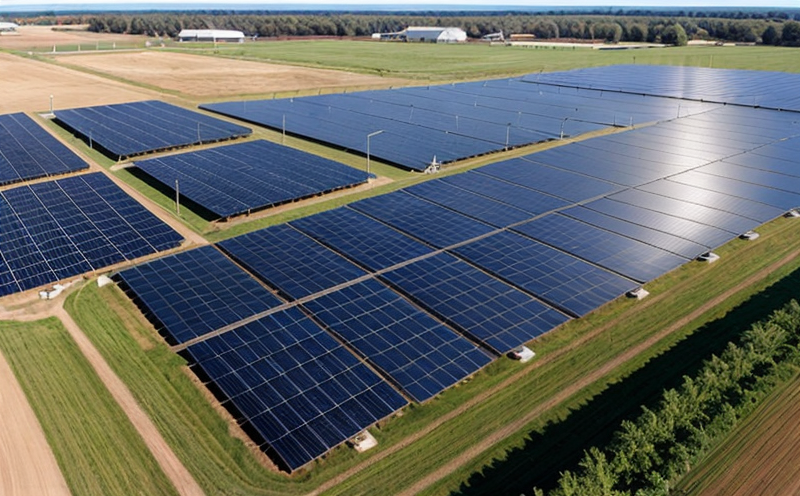UL 2267 Fuel Cell System Safety Testing in New Energy Systems
The UL Standard 2267, titled "Performance and Safety Requirements for Residential Fuel Cell Systems," is a critical document that sets the benchmark for ensuring safety and reliability of fuel cell systems within residential settings. This standard aims to provide robust guidelines that manufacturers must follow to ensure their products are safe for use in homes.
Fuel cells represent an emerging technology in renewable energy, offering a clean alternative to traditional fossil fuels by converting hydrogen directly into electricity without combustion. As the demand for sustainable and efficient energy solutions grows, so too does the importance of rigorous safety testing before these technologies can be deployed widely. UL 2267 specifically addresses this need by providing stringent performance and safety criteria that must be met.
The testing process under UL 2267 involves several key steps which include:
- Performance evaluation to ensure the system meets efficiency targets
- Safety assessments focusing on fire risk, toxic gas emissions, and other hazards
- Evaluation of environmental impacts during operation
These tests are conducted using advanced equipment capable of simulating real-world conditions. Specimens for testing typically include complete fuel cell systems or individual components such as stacks, reformers, and power management units.
The results from these tests are then analyzed to determine compliance with specified parameters outlined in UL 2267. Compliance ensures not only that the system functions correctly but also that it poses minimal risk to users and surrounding environments. This level of assurance is crucial given the increasing reliance on residential fuel cells as part of broader renewable energy strategies.
By adhering to this standard, manufacturers can demonstrate their commitment to quality control and safety standards which are essential for gaining market acceptance and regulatory approval.
| Test Parameter | Description |
|---|---|
| Efficiency | The ratio of electrical energy produced by the fuel cell system to the chemical energy contained in the hydrogen feedstock. A high efficiency indicates that less fuel is needed for a given output. |
| Fire Risk Assessment | An evaluation of potential fire risks associated with the operation of the fuel cell system, including ignition sources and heat generation. |
| Toxic Gas Emissions | The measurement of toxic gases like carbon monoxide produced during the operation of the fuel cell. Low levels are desirable to ensure safety. |
| Acceptance Criteria for UL 2267 Compliance |
|---|
| The system must pass all tests without exceeding specified limits. |
| All data points must meet the acceptance criteria outlined in UL 2267. |
| No safety issues or failures should occur during testing. |
In summary, compliance with UL 2267 is vital for any manufacturer looking to enter into the growing market of residential fuel cell systems. It ensures not only regulatory compliance but also enhances consumer confidence through proven safety measures.
Industry Applications
The implementation of UL 2267 has significant implications across various sectors, particularly those involved in the development and deployment of renewable energy technologies. Here are some key areas where this standard plays a crucial role:
| Sector | Application |
|---|---|
| Residential Construction | Ensuring safe integration of fuel cell systems into homes. |
| Renewable Energy Development | Facilitating the adoption of residential fuel cells as part of broader energy strategies. |
| Environmental Sustainability | Promoting cleaner, more sustainable energy solutions within urban environments. |
The standard's focus on safety and performance ensures that fuel cell systems can be seamlessly integrated into existing infrastructure without compromising public health or environmental integrity. This makes it particularly valuable for residential construction firms aiming to incorporate cutting-edge technology into their projects, as well as renewable energy developers looking to expand their product offerings.
Quality and Reliability Assurance
The quality assurance processes associated with UL 2267 are designed to ensure that fuel cell systems meet the highest standards of safety and reliability. This involves multiple stages, each aimed at identifying potential weaknesses early in the development process.
Stage One: Design Review
This initial stage focuses on reviewing the design plans for any fuel cell system intended to comply with UL 2267. The aim here is to catch any potential issues before production begins. This includes evaluating the overall design, component selection, and expected performance.
Stage Two: Prototype Testing
The second stage involves testing prototypes under controlled conditions. This helps identify any discrepancies between theoretical predictions and actual performance. It also allows for adjustments to be made before full-scale production begins.
Stage Three: Production Lot Sampling
In this final stage, samples from the first few lots of produced units undergo rigorous testing. The goal is to ensure that all units meet the stringent requirements set by UL 2267 consistently. Any deviations found are addressed immediately.
The combination of these stages provides a comprehensive approach to quality and reliability assurance, ensuring that only safe and reliable fuel cell systems reach the market.
International Acceptance and Recognition
UL 2267 enjoys widespread recognition and acceptance both domestically and internationally due to its rigorous approach and comprehensive scope. Many countries have adopted this standard as a benchmark for fuel cell system safety, recognizing the importance of ensuring public safety while promoting innovation.
The United States has been at the forefront in adopting such standards, with UL 2267 being one of several critical documents used by regulatory bodies like the National Fire Protection Association (NFPA) and the International Code Council (ICC).
Internationally, organizations such as the European Committee for Standardization (CEN), British Standards Institution (BSI), and Japan Industrial Standards Committee (JISC) have referenced or incorporated UL 2267 into their own standards. This cross-border recognition highlights its significance in setting global benchmarks for fuel cell system safety.
For manufacturers looking to expand internationally, compliance with UL 2267 can significantly enhance their credibility and market access opportunities. It demonstrates a commitment to international best practices and helps overcome regulatory barriers.





